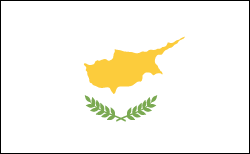
National name:
Kypriaki Dimokratia—Kibris Cumhuriyeti
Current government: officials
Languages:
Greek, Turkish (both official); English
Ethnicity/race:
Greek 77%, Turkish 18% (each concentrated almost exclusively in separate areas); other 5% (2001)
National Holiday:
Independence Day, October 1
Religions:
Greek Orthodox 78%, Islam 18%, Maronite, other (includes Maronite and Armenian Apostolic) 4%
Literacy rate:
98.7% (2011 est.)
President:
Nikos Anastasiadis (2013)
Land area:
3,568 sq mi (9,241 sq km); total area: 3,571 sq mi
Population (2014 est.):
1,172,458 (growth rate: 1.48%); birth rate: 11.44/1000; infant mortality rate: 8.54/1000; life expectancy: 78.34
Capital and largest city (2011 est.): Necosia 253,000
Currency:
Euro
![]()
Geography
The third-largest island in the Mediterranean (one and one-half times the size of Delaware), Cyprus lies off the southern coast of Turkey and the western shore of Syria. The highest peak is Mount Olympus at 6,406 ft (1,953 m).
Government
Republic. Mediation efforts by the UN seek to reunify the Greek and Turkish areas of the island under one federated system of government.
History
Cyprus was the site of early Phoenician and Greek colonies. For centuries its rule passed through many hands. It fell to the Turks in 1571, and a large Turkish colony settled on the island.
In World War I, at the outbreak of hostilities with Turkey, Britain annexed the island. It was declared a Crown colony in 1925. The Greek population, which regarded Greece as its mother country, sought self-determination and union(enosis) with Greece. In 1955, a guerrilla war against British rule was launched by the National Organization of Cypriot Combatants (EOKA). In 1958, Greek Cypriot nationalist leader Archbishop Makarios began calling for Cypriot independence rather than union with Greece. During this period, Turkish Cypriots began demanding that the island be partitioned between the Greek and Turkish populations.
Cyprus became an independent nation on Aug. 16, 1960, after Greek and Turkish Cypriots agreed on a constitution, which excluded both the possibility of partition as well as of union with Greece. Makarios became the country’s first president.
Fighting between Greek and Turkish Cypriots flared up in the early 1960s, and a UN peacekeeping force was sent to the island in 1965. On July 15, 1974, Archbishop Makarios was overthrown in a military coup led by the Cypriot National Guard. On July 20, Turkey invaded Cyprus, asserting its right to protect the Turkish Cypriot minority. Turkey gained control of 30% of northern Cyprus and displaced some 180,000 Greek Cypriots. A UN-sponsored cease-fire was established on July 22, and Turkish troops were permitted to remain in the north. In Dec. 1974, Makarios again assumed the presidency. The following year, the island was partitioned into Greek and Turkish territories separated by a UN-occupied buffer zone.
Turkish Cypriots proclaimed a separate state under Rauf Denktash in the northern part of the island on Nov. 15, 1983, naming it the “Turkish Republic of Northern Cyprus.” The UN Security Council, in its Resolution 541 of Nov. 18, 1983, declared this action illegal and called for withdrawal. No country except Turkey has recognized this entity.
In 1988, George Vassiliou, a conservative and critic of UN proposals to reunify Cyprus, became president. The purchase of missiles capable of reaching the Turkish coast evoked threats of retaliation from Turkey in 1997, and Cyprus’s plans to deploy more missiles in Aug. 1999 again raised Turkey’s ire.
Strife Continues Between Greek Cypriots and Turkish Cypriots
The continued strife between Greek Cypriots and Turkish Cypriots threatened Cyprus’s potential EU membership—it had met all the economic standards—and provided a great incentive to both sides to resolve their differences. UN-sponsored talks between the Greek and Turkish leaders, Kleridas and Denktash, continued intensively in 2002, but without resolution. In Dec. 2002, the EU invited Cyprus to join in 2004, provided the UN plan was accepted by February 2003. Without reunification, only Greek Cyprus was to be welcomed into the EU. But just weeks before the UN deadline, President Kleridas was defeated by right-wing candidate Tassos Papadopoulos, a hard-liner on reunification. The UN deadline passed, and the UN declared that the talks had failed. In April 2004, dual referendums were held, with the Greek side overwhelmingly rejecting the most recent UN reunification plan, and the Turkish side voting in favor. In May, Greek Cyprus alone became a part of the EU.
In April 2005, Turkish Cyprus elected pro-reunification leader Mehmet Ali Talat as their president, ousting longtime leader Rauf Denktash, who staunchly opposed reunification. In July 2006, the UN sponsored talks between President Papadopolous and Talat.
In the second round of presidential elections in February 2008, Community Party leader Dimitris Christofias won 53.4% of the vote, defeating right-wing candidate Ioannis Kasoulidis, who took 46.6%. Christofias, who is Cyprus’s first Commnunist president, vowed to work toward reunification and said he would meet with the Turkish Cypriot president, Talat. Papadopoulos was eliminated in the first round of voting.
On March 21, 2008, President Christofias started talks of reunification with Turkish Cypriot president, Talat, as promised. Talks continued through 2009, though little progress was achieved.
On April 4, 2008, Ledra Street Crossing was torn down—an important symbolic step towards reunification. The checkpoint divided Greek and Turkish Cypriots in the capital city of Nicosia for decades.
In presidential elections in North Cyprus in April 2010, Dervis Eroglu, the leader of the pro-independence National Unity Party won 50.4% of the vote, defeating incumbent Mehmet Ali Talat, who is pro-unity.
Economic summary:
GDP/PPP:
$21.62 billion (2013 est.); $24,500 per capita (2013 est.).
Real growth rate:
–8.70%.
Inflation:
0.2% (2013 est.).
Unemployment:
17.4%.
Arable land:
9.06%.
Agriculture:
citrus, vegetables, barley, grapes, olives, vegetables; poultry, pork, lamb; dairy, cheese.
Labor force:
443,500 (2013); agriculture, 8.5%; industry, 20.5%; services, 71% (2006).
Industries:
tourism, food and beverage processing, cement and gypsum production, ship repair and refurbishment, textiles, light chemicals, metal products, wood, paper, stone, and clay products. Natural resources: copper, pyrites, asbestos, gypsum, timber, salt, marble, clay earth pigment.Exports: $2.42 billion (2013 est.). Imports: $4.747 billion (2013 est.).
Major trading partners:
UK, Greece, Germany, France, Italy, Israel, Netherlands, China (2006).
Member of Commonwealth of Nations
Communications: Telephones:
main lines in use: 373,200 (2012). Mobile cellular: 1.11 million (2012).
Broadcast media:
mixture of state and privately run TV and radio services; the public broadcaster operates 2 TV channels and 4 radio stations; 6 private TV broadcasters, satellite and cable TV services including telecasts from Greece and Turkey, and a number of private radio stations are available; in areas administered by Turkish Cypriots, there are 2 public TV stations, 4 public radio stations, and privately owned TV and radio broadcast stations (2007).
Internet hosts:
252,013 (2012).
Internet users:
433,900 (2009).
Transportation: Railways:
0 km.
Highways:
20,006 km; paved: 8,564; unpaved: 4,442 km (2011); under government control: 13,006 km (includes 2,277 km of expressways); under Turkish Cypriot control: 7,000 km.
Ports and harbors:
area under government control: Larnaca, Limassol, Vasilikos; area administered by Turkish Cypriots: Famagusta, Kyrenia.
Airports:
15 (2013).
International disputes:
hostilities in 1974 divided the island into two de facto autonomous entities, the internationally recognized Cypriot Government and a Turkish-Cypriot community (north Cyprus); the 1,000-strong UN Peacekeeping Force in Cyprus (UNFICYP) has served in Cyprus since 1964 and maintains the buffer zone between north and south; on 1 May 2004, Cyprus entered the European Union still divided, with the EU’s body of legislation and standards (acquis communitaire) suspended in the north; Turkey protests Cypriot Government creating hydrocarbon blocks and maritime boundary with Lebanon in March 2007.
Cyrpus Requests Bailout from European Union
In June 2012, Cyprus requested a $17 billion bailout from the European Union to bolster its ailing banks. In March 2013, the EU and IMF offered $13 billion and requested that Cyprus raise $7.5 billion by taxing all bank deposits. Deposits over 100,000 euros would face a rate of 9.9%, while deposits less than that would be taxed 6.75%. The proposal sparked protests in Cyprus and outrage in Russia—many wealthy Russians put their money in Cyprus banks, which are not heavily regulated. Parliament rejected the bail-out, and the threat of Cyprus being ousted from the euro zone loomed large.
Days later, the EU and Cyprus agreed to an alternative bail-out package that spared deposits of less than 100,000 euros the tax. Instead, the deal would restructure the country’s weakest banks, the Bank of Cyprus and Laiki Bank. The Laiki Bank will be shut down, and deposits of less than 100,000 euros in the bank will be transferred to the Bank of Cyprus. Customers with deposits in excess of 100,000 euros stand to lose their assets because the larger deposits will be used to shoulder Cyprus’s commitment to the bail-out. In return, Cyrpus will receive 10 billion euros ($13 billion) in loans. While the deal allowed Cyprus to remain in the euro zone, it leaves Cyprus with enormous debt and a future of austerity measures and sends a shiver to other struggling nations in the EU.
Anastasiadis Becomes President in 2013
On February 17, 2013, the presidential election was held. Leader of the right-wing Democratic Rally party, Nikos Anastasiadis won. Former Minister of Health and Progressive Party of Working People candidate Stavros Malas came in second, setting up a runoff, which was held a week later. Anastasiadis won the runoff, receiving 57.5 percent of the vote. Anastasiadis took office on February 28, 2013.












